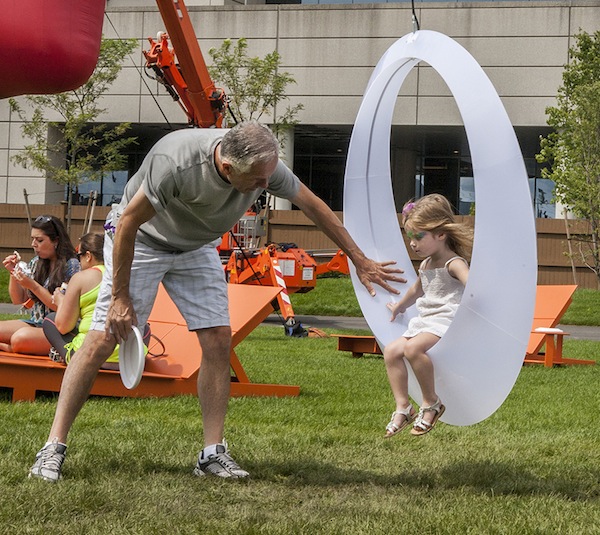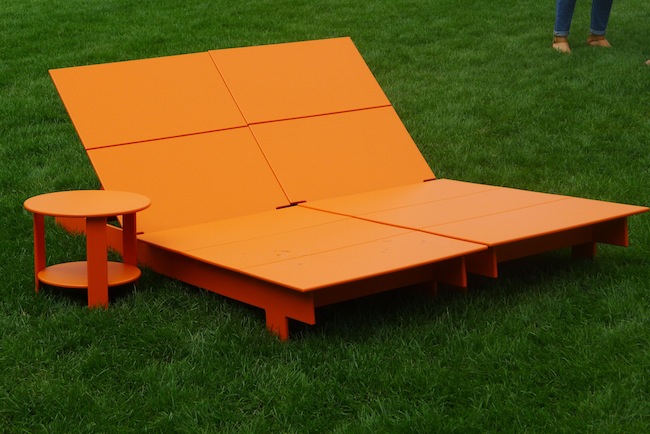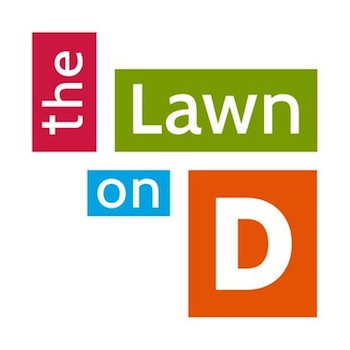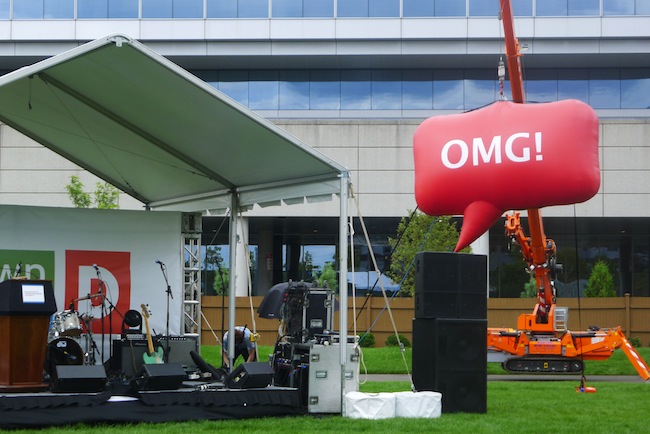Visual Arts Commentary: The Lawn on D — A New Park Paradigm in South Boston
The Lawn on D is a breath of fresh cultural air in Boston.
The Lawn on D can be most easily accessed by driving down D Street in South Boston. It is open seven days a week.
By Mark Favermann
In the past few decades, throughout America, public art has been seen as a panacea for urban woes. All too often, leftover and/or unprogrammed spaces in the urban fabric are handed over to artists, who are charged to create something visionary on the sites, or at least to whip up something strongly visual or provocative.
Does this really work? Short answer: not always.
Like other cities, Boston has reached out to the arts community to assist with urban design. The former Big Dig has been transformed into the Greenway, which has commissioned both temporary and permanent public art projects. Nearby, parts of South Boston, including the Fort Point Channel area, have been rechristened (confusingly) the South Boston Waterfront, Seaport, and Innovation Districts. Visual artists have been engaged here and there to assist in putting over this awkward, multiple re-branding effort.
Last month at the Boston Society of Architects (BSA), the international cultureNOW – MuseumWithoutWalls brought together a group of prominent New England artists and arts administrators to take part in a conversation about the role of public art plays in shaping and transforming urban spaces. The panel addressed weighty questions: “What is the role of public art in creating a sense of community in Boston’s waterfront? What is the role of public art in creating a sense of place? What is the right approach? How should we assess it? And what are the metrics we need to use to evaluate its success?” For over two and a half hours the speakers wrestled with these thorny issues. The majority of the interested crowd stayed through to the end. Predictably, the questions were only partially answered. A follow-up panel is scheduled for January.
A few days after the confab, I received notification of a previously unprogrammed space that was going to be used as a multiple use park for public art and performances adjacent to the Boston Convention and Exhibition Center (BCEC). This site, owned by the Massachusetts Convention Center Authority, will be programmed for 18 months or longer depending on development options.
This project, The Lawn on D, was slated to be yet another demonstration of how public art could fill a gaping hole in the fabric of the city. I was cynical, to say the least. Would this be just another half thought-out attempt to repair torn urban tapestry? Just a band-aid stuck on an annoying civic sore? It turns out that my skepticism was misplaced, for once.
The Lawn on D turns out to be an innovative way to fill a space temporarily. The result of an innovative strategy the BCEC administration has dubbed “guerilla urbanism,” the new park, which spans a 2.7 acre parcel, was unveiled on August 15. Its official ribbon cutting proffered a live music performance, public seating, lounge chairs, public art (in rotation), food trucks, lawn games, photo ops, wi-fi, and remarks by Mayor Marty Walsh and other dignitaries. The Lawn at D opened to the public the next day. As far as urban interventions go, this outdoor interactive landscape was created at warp speed — planning and design began last January, actual construction in the Spring. The project cost $1.1 million. Clearly, when there is a strong institutional will there will be a park.
According to press release materials, The Lawn on D is dedicated to bolstering civic engagement and fostering creativity. The BCEC authorities understand that this park is an experiment from which to learn and improve. They expect some elements to succeed and others to fail. The idea behind this approach, of course, is to see what works best for the park, the Convention Center, and the neighborhood. Sasaki Associates of Watertown was the landscape architect collaborating with Utile, Inc. urban planners. The park is part of an initiative to transform D Street through a carefully choreographed re-development of several connected parcels of land.
Jim Rooney, Executive Director of the Massachusetts Convention Center Authority, saw to it that The Lawn on D would reflect a flexible framework, physically and programmatically. The space is experimental as well as experiential — feedback from those who use the park will be drawn on to refine future elements and events. Kudos to Mr. Rooney for this interactive approach: a son of Southie who went to Harvard University, he wants to ensure that BCEC is a good neighbor.
Inspired by a spirit of cooperation, the Lawn at D is the first park of its kind in the United States. Other national convention centers are isolated from their neighbors and neighborhoods: one of the enduring failures of NYC’s Bloomberg administration was continuing the seclusion of the Javitts Center. In other outreach efforts, the BCEC has also hired neighborhood young people to man the Convention Center’s parking lots and for neighborhood retirees to act as greeters. Visually, the park along D Street greens up the neighborhood, softening the bleak wall of new, hard-edged condos and apartments.
The Lawn on D is one of those rare urban spaces that was designed with the temporary exhibition of public art in mind. D Street ArtLab has fostered both large- and small-scale public art installations created by artists renowned locally as well as internationally. Curated by Kate Gilbert, a wide range of public art is on display: the lineup includes inflatables, light sculptures, cartoon images of members of the community, collages, and digital animations. The artists include Megan and Murray McMillen, Will Pappenheimer, Pat Falco, Tim McCool, Karl Stevens, Silvia Lopez Chavez, Norm Magnusson, Scottie Webb, Maria Molteni, Brian Kane, and Joanne Kaliontzis. One of the major pieces in the park is already winning public approval: “Swing Time,” an interactive lighting-enabled adult/children swing designed by the firm of Howeler + Yoon Architecture. By mid-September there will be 29 more swings of various colors and sizes installed.
The park will be seasonally programmed; the schedule for winter events is currently being worked out. A curling area is among the suggestions. Though most of the performance events and concerts will be free to the public, there be a few reasonably priced ticketed events. Development and programming consultants HR&A Advisors, Inc. (HR&A) and event guru Chris Wangro advised BCEC on the park project.
The Lawn on D is a breath of fresh cultural air in Boston. On many levels it is a welcome paradigm for the future — an urban oasis of creativity and greenery in a concrete and asphalt desert.
An urban designer, Mark Favermann has been deeply involved in branding, enhancing, and making more accessible parts of cities, sports venues, and key institutions. Also an award-winning public artist, he creates functional public art as civic design. Mark created the Looks of the 1996 Centennial Olympic Games in Atlanta, the 1999 Ryder Cup Matches in Brookline, MA, and the 2000 NCAA Final Four in Indianapolis. The designer of the renovated Coolidge Corner Theatre, he has been a design consultant to the Red Sox since 2002.




